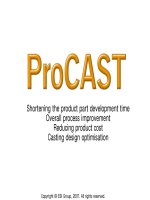academic tasks literature reviews presentation
Bạn đang xem bản rút gọn của tài liệu. Xem và tải ngay bản đầy đủ của tài liệu tại đây (1.79 MB, 21 trang )
Academic Writing Tasks:
Literature Reviews
Student Development Services
Writing Support Centre
UCC 210
www.sds.uwo.ca/writing
1
An essential component of any graduate degree is being aware of the work done by others in your field. The literature review is your opportunity to demonstrate your expertise in your chosen
discipline.
Outline
Literature Reviews and Grad Students
Gathering and Synthesizing the Literature
Organizing and Writing the Literature Review
2
Literature Reviews
Amalgamate and summarize relevant literature for a
particular topic
Do not present new research or findings
Unless in the very early stages
Referred to as secondary literature
3
Literature reviews gather and organize as much relevant literature as possible for a given subject. They do not present new research or findings unless it is a casual mention used to supplement
the review material. Because a review does not present any new research or findings, and only discusses the primary literature, reviews are often referred to as ‘secondary literature.’
Literature Reviews
Two distinct styles:
Annotated bibliography
Organized references in paragraph form
Critical evaluation
Commenting on the findings of papers, direction of
the subject
4
There are two distinct styles of literature reviews. Annotated bibliographies are little more than references grouped together and written in full sentences. The more common literature review is a
critical evaluaiton of the literature. In these cases, the author is not merely summarizing the literature, he or she is commenting on the findings of papers, discussing the direction of the subject.
The literature is used as a tool to support the authors main argument, rather than just being a glorified bibliography.
Reviews and Grad Students
Thesis
Proposal
Chapter
Review/Survey Paper
Commissioned Reviews
Introduction for Manuscript
Grant and Scholarship Proposals
5
Literature reviews crop up numerous times throughout the life of a graduate student. They may have different names (e.g. survey paper, review paper), and the structure will be different almost
every time you write one, the general purpose will always be the same. The literature review is an essential component of the thesis. Whether it is part of the proposal or it stands alone as a
whole chapter, it is your opportunity to show your level of knowledge in your field. Especially successful literature reviews of novel subjects may be submitted as manuscripts; although, reviews
are often written by experts in the field, this may be a way to get an easy publication under your belt. You should write to journals to see if they would be interested in a review before expending
too much time and energy. Most manuscripts have a literature review section that either stands alone or is incorporated into the introduction. Many grant and scholarship proposals ask for a
short literature review to orient the selection committee to your subject.
Gathering the Literature
You should read as much as possible
Use your library; talk to librarians
Reference software (e.g. Endnote) can help you keep
track of references and save time compiling your list
6
As for writing a review, the first step is to start reading. Use the strategies you’ve used throughout your undergraduate degree to sort through as many papers on your subject as possible. While
you probably won’t be able to read everything, a review should cover as much ground as possible. Start with the most important papers and branch out from there. Over the course of reading
the papers, you should start to think about what direction your paper will go in. This will allow you to actively search out relevant papers and skim or ignore the less important ones.
Snowball Literature Search
Find the most recent article on your topic
Find all the relevant articles cited in that paper
Find all the relevant articles cited in them etc.
Limited to looking backward
7
The ‘Snowball’ method for acquiring literature is one way of finding many articles on your subject. To accomplish this, find the most recent, relevant articleo n your topic. From here, find all the
relevant papers cited in this article, and all the relevant articles cited in that one. This is limited by looking backward, but by starting with multiple papers, you should be able to find all the relevant
papers.
Synthesizing the Literature
Develop your own methods for reviewing papers
Write while you read
Take good notes
Write a short paragraph describing the paper
Connect the paper with other literature
8
Once you’ve found a paper, you should develop an effective but efficient method for reviewing it. You should never just read a paper. While you are reading, you should take point form notes
summarizing the paper, write a short paragraph about it, and/or connect this paper with others you’ve read.
Organizing the Literature
You should read everything, but you should not write
about everything
Focus on the relevant papers and key findings
9
While you should read as much as you can, you need not write about absolutely everything you’ve read. You are doing the work for the reader, including only the most relevant literature.
Organizing the Literature
Adopt a general structure for your review based around
your objectives
10
At this stage, you should adopt a general structure for the review that will support your objectives.
Organizing the Literature
Objective: Deconstruct and make connections for a
topic
Structure: Make logical groups/headings
Objective: Detail the development of a topic over the
years
Structure: Chronological Order
11
If you are deconstructing a complicated topic, making logical groups based around headings will help you put your papers into distinct categories and give the reader a clear structure.
If you are discussing how a topic has developed over the years, chronological order would be a good way to organize the literature.
Organizing the Literature
Objective: Review a controversial topic
Structure: Compare/Contrast; Point/Counterpoint
Objective: Detail multiple views on one topic
Structure: Enumeration
12
If you are reviewing a controversial topic, you may want to adopt a compare/contrast structure.
If there are several views on a topic, you may want to group them into headings and number them to show that there are distinct groups.
Outlines and Freewriting
Need some general structure before you start writing
13
Most people develop a general stucture for a text before writing. The content of literature reviews makes this quite easy.
Outline
Start with headings and group your references
Write out topic sentences for each paragraph
Re-organize (split, merge, add, delete)
Start writing
14
When writing an outline, you may start out by establishing a rough idea of what your headings will be and then place your references into the appropriate headings. From here, you can write
topic sentences for each paragraph that you are writing, and again, organize your references into the appropriate paragraphs. With the general structure established, you should re-organize any
sections that need a little work and then start writing the body of your text.
Freewriting
Brainstorm the general focus of your paper
Take a few key references (5 or 6) and write a short
paper
Start expanding on your main ideas and fill in details
15
If outlining isn’t to your taste, you can try freewriting. You should have a general idea about what the general focus of your paper will be. With this in mind, use a few key references and write a
short paper. It can be as short as an abstract or as long as a few pages. From here, start expanding your main ideas and fill in with more references and details to support your arguments.
Review Article
Manuscripts submitted to journals that do not present
new research
May summarize one or many articles
Usually commissioned by journals
If there are previous reviews, you may want to focus on
literature published after the initial review
16
Review Article - Audience
Audience less specialized
Readers want to keep up on the literature
Use general language
Focus on the big ideas
17
When writing a literature review as a review article, it is important to be aware of you audience. They are likely less specialized than people that would read your primary research. They are just
trying to keep up to date on the literature. You should use general language wherever possible and try to focus on the big ideas about your topic and not get bogged down in the details.
Thesis Literature Review
Complete and comprehensive look at the relevant
literature related to your thesis
May stand alone as a chapter in your thesis
18
The literature review for your thesis may be a little more technical. It is supposed to be a complete and comprehensive look at the literature as it relates to your thesis.
Lit Review: Introduction
Effective introductions maintain interest throughout
review
The first paragraph in each section helps audience
decide whether to read, skim or skip
Be clear about the content of each section
19
When writing an introduction for a literature review, it is important to introduce all of the main ideas of the paper you will be writing. You want to maintain the reader’s interest throughout the
paper, and you can do this by clearly showing how all the ideas that you are about to develop are related to each other. At the beginning of each section, you should give the reader enough
detail to be able to decide whether she or he should read the whole section, skim it or skip it.
Lit Review: Body
Change up your sentence length and types
Use active verbs and the active voice
Avoid “Author A found Author B found Author C
found ”
Review the literature, don’t just summarize dozens of
papers (make connections)
20
The main text of literature reviews are notorious for being difficult and boring to read. You can make this easier by using a more exciting writing style. Try to use active verbs and the active voice.
The structure should be clear and consistent, but by changing up your writing style, you will be able to to keep your reader’s attention longer.
Lit Review: Conclusions
Generalize and summarize
Where will the research go from here?
Stays in the reader’s mind
21
The conclusion is your opportunity to generalize and summarize all of the literature that you’ve discussed in this section or paper. Because you are writing the paper from your perspective, it is
appropriate to write about what direction you think the research will be going. It is the last section, so it will stay in the reader’s mind, and it is a good opportunity to repeat the most important
aspects of your review.









